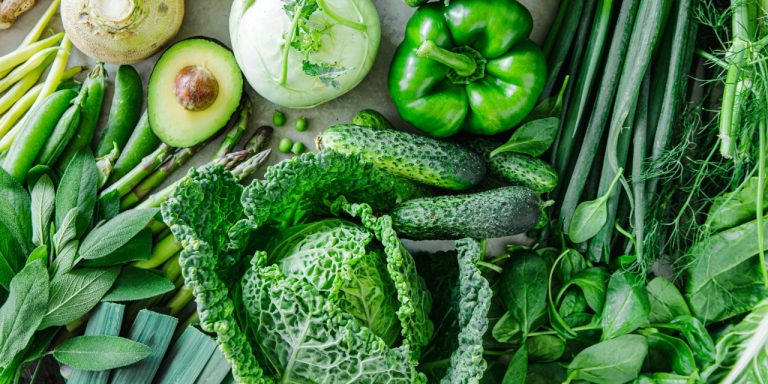
Alkaline foods: an overview
What classes a food as alkaline? Are lemons, rice, eggs and oats alkaline? What do PRAL value and pH value have to do with alkaline foods? Find out more about alkaline foods and they effect they have in the body.
What are alkaline foods?
Alkaline foods are foods that the body breaks down into alkali. They contain lots of minerals and trace elements like potassium, magnesium, iron and calcium. By contrast, they are low in amino acids – distinguishing them from acidic foods (e.g. cereal products and dairy products). The body breaks down acidic foods into acids. The body needs 70% to 80% alkaline and 20% to 30% acidic foods for a healthy, balanced diet. Alkaline foods are identified by their low PRAL value.
What is a PRAL value?
PRAL stands for potential renal acid load. The PRAL value indicates how much acid is produced from a food during metabolization. A positive PRAL value indicates an acid-forming effect. A negative value, on the other hand, is indicative of an alkaline effect.
The pH value measures how acidic or alkaline a solution is. Its scale ranges from zero to fourteen. The lower the pH value, the more acidic the solution. A value of seven is considered neutral. If the value is above this, the solution is alkaline.
In food, pH value only describes the current state. As soon as the body metabolises a food, it changes its pH value. So the pH value isn’t significant in food. The PRAL value serves as a better reference point: it shows whether a food forms acids or alkali during metabolization, thereby illustrating its long-term effect in the body.
Why are alkaline foods important?
Certain parts of our body are alkaline when healthy. These include connective tissue, the lymph and the small intestine. Others are acidic – such as the vagina, stomach and colon. The pH value of our blood is 7.36. The body tries to keep this value constant at all times, because even minor changes can be dangerous.
The body simply excretes alkali after it has processed them, whereas it has to neutralise acids first. To do this, it needs enough alkaline minerals. If these are not available, it plunders the body’s own stocks: it takes minerals from the bones, teeth, scalp and vital organs. If this process occurs over a longer period of time, it can cause damage such as tooth decay, hair loss and osteoporosis (bone loss). A balanced diet rich in alkaline foods will enable you to provide your body with sufficient alkaline minerals.
Which foods are alkaline?
Below are some examples of alkaline foods and their PRAL value. Take note: this is not an exhaustive list. A more comprehensive overview of alkaline foods can be found in tables online.
Are lemons alkaline?
Lemons are classed as alkaline. Their PRAL value is -2.6. Although they are acidic in nature, the body metabolises them into alkali: predominantly alkaline substances, such as potassium and magnesium, remain.
Are apples alkaline?
Apples have a PRAL value of -2.2, so they are also classed as alkaline foods. But they are relatively low alkaline in comparison to bananas.
Are bananas alkaline?
Bananas are classed as a highly alkaline food with a PRAL value of -7. They are also filling and provide your body with energy.
Are tomatoes alkaline?
Tomatoes are also an alkaline food. They have a PRAL value of -3.1.
Is avocado alkaline?
With a PRAL value of -8.7, avocado is a highly alkaline food. Avocados are also a source of folic acid and vitamin D. Avocado sometimes get a bad reputation because it is relatively high in fat. However, its fats are valuable and, in some cases, even reduce cholesterol levels.
Are potatoes alkaline?
Potatoes have a PRAL value of -6 and are therefore classed as an alkaline food. They also keep you fuller for longer and provide the body with calcium, carbohydrates and vitamin C.
The pH value measures how acidic or alkaline a solution is. Its scale ranges from zero to fourteen. The lower the pH value, the more acidic the solution. A value of seven is considered neutral. If the value is above this, the solution is alkaline.
In food, pH value only describes the current state. As soon as the body metabolises a food, it changes its pH value. So the pH value isn’t significant in food. The PRAL value serves as a better reference point: it shows whether a food forms acids or alkali during metabolization, thereby illustrating its long-term effect in the body.
Is rice alkaline?
Rice is not alkaline. Husked and cooked it has a PRAL value of 1.7. But rice is classed as a “good acidifier”: good acidifiers form acids during metabolization, but they are rich in protein and lots of vital nutrients. This means they have just as much of a place on the menu as alkaline foods – just in smaller quantities.
Are oats alkaline?
Oats have a PRAL value of 10, meaning oats are not alkaline, but like rice, they are one of the good acidifiers. By the way, sprouted oats have a lower PRAL value. Germination breaks down various substances – providing the body with more minerals and trace elements.
Are lentils alkaline?
Like pulses in general, green and brown lentils are not alkaline. But pulses are also good acidifiers because they are rich in proteins.
Are eggs alkaline?
Eggs are not alkaline either. For instance, chicken eggs have a PRAL value of 8.2, so eggs and other organically farmed products are classed as good acidifiers.
Is cottage cheese alkaline?
Cottage cheese has a PRAL value of 8.7. As such, this is classed as an acidifying and not an alkaline food.
Is yoghurt alkaline?
Yoghurt is a slightly acidic food. Natural yoghurt has a PRAL value of 1.5, and fruit yoghurt 1.2.
Is cider vinegar alkaline?
Cider vinegar might taste acidic, but it’s actually an alkaline food. It has a PRAL value of -2.3.
The Swiss Society for Nutrition’s food pyramid contains both alkaline and acidic foods. It serves as a good reference framework for a balanced diet. So eat a varied diet and ensure a good balance: eat 70% to 80% alkaline foods and 20% to 30% good acidifiers to ensure you benefit from the positive effects of this in the long term.

The expert provided the editorial team with advice and input for this article. Nadia Cifarelli (BSc Psychology, certified holistic health advisor) works for the Helsana health consultation service. She helps customers on issues to do with prevention, nutrition and mental health.


Newsletter
Find out more about current health issues every month and get all the information you need about our attractive offers from all Helsana Group companies * delivered by e-mail to read whenever it suits you. Our newsletter is free of charge and you can sign up here:
We did not receive your information. Please try again later.
* The Helsana Group comprises Helsana Insurance Company Ltd, Helsana Supplementary Insurances Ltd and Helsana Accidents Ltd.